Final report for ONE18-315
Project Information
With the expansion of the craft brew industry, locally-grown hops have emerged as a potential new enterprise for farmers in Maryland and the Mid-Atlantic region. With this new enterprise comes new challenges; hops have not been cultivated on a commercial scale in Maryland for over 100 years due to prohibition. After prohibition, the commercial hops industry settled into the Pacific Northwest--a climate much better suited for hops production. As a result, there is a dearth of knowledge regarding hops production in Maryland and the Mid-Atlantic, making it difficult for farmers to determine if hops are a viable agriculture enterprise for their business.
In order to begin evaluating and determining production recommendations for Maryland hops, we established a 1/4-acre hops yard at the Western Maryland Research & Education Center in Keedysville, MD in 2016. This hops yard consisted of 12 hops varieties replicated three times. The yard was then expanded to 1/2-acre in 2017 with the addition of 12 new varieties that were selected in consultation with farmers and brewers. The primary objectives of this variety trial is to: 1) Determine varieties that are suitable for Maryland's unique climate that have good yield and brewing potential; 2) Determine best management practices for hops production in Maryland (from planting to harvesting and processing); 3) Determine production cost; and 4) Evaluate the potential for hops as an agricultural enterprise for Maryland farmers by taking into consideration production, processing, marketing, and brewing capabilities of locally-grown Maryland hops.
In order to achieve these goals, a partnership was established with Flying Dog Brewery; the largest craft brewery in Maryland. This partnership allowed us to generate unbiased, research-based data on not only production, but also processing and brewing, which are two key components to determining if hops are a viable enterprise for our local farmers. Growing hops is just one piece of the puzzle; they need to also be processed correctly and must posses qualities that brewers desire--otherwise, there is no market for the product.
This multi-year project is supported through several grants, but this SARE grant in particular helped determine information on pest management and fertility, yield and harvest information, and chemical/oil profile of Maryland-grown hops.
Regarding pest management; hops downy mildew, spider mites, leafhoppers, and Japanese beetles were the most significant pests in the hopsyard. These were managed with pesticides using Integrated Pest Management (IPM) practices. Hops yield varied greatly by variety with Canadian Red Vine, Zeus, Southern Brewer, Nugget, and Southern Cross topping the list. Harvest window and harvest time can fluctuate greatly from year-to-year as a result of Maryland's variable climate. Cones were harvested using a hops harvester at approximately 25% dry matter.
Once harvested, hops must be processed and handled properly to achieve a quality product for brewing. Hops cones were placed in a drying oast immediately after harvest to dry the cones to 8% moisture in less than 24 hours and frozen in vacuum-sealed bags in liquid nitrogen until they could be pelletized. Hops were pelletized while frozen using a hammer mill, then placed back in vacuum-sealed bags and frozen. This is the final product that was then sent to Flying Dog Brewery where they did their brew quality analysis. Processed hops were also sent to Virginia Tech to get a complete chemical and oil analysis profile on each variety.
Based on Flying Dog's brewing analysis and the chemical/oil profile data from Virginia Tech, the top-rated varieties for brewing included: Vojvodina, Southern Cross, Southern Brewer, Glacier, and Sorachi Ace. Interestingly, the top-rated hops in 2018 were not the same as in 2017, which indicates that chemical and oil profiles of the hops change as the plants mature. Based on the brew quality and yield data, there are some varieties that may have potential to achieve desirable yields and brewing qualities.
As a result of this project we are starting to develop hops production recommendations for Maryland and Mid-Atlantic hops based on objective data on both production and brewing quality. We have produced the Maryland Hops Growers Guide in collaboration with Flying Dog Brewery and have an Extension Fact Sheet in review that covers production recommendations.
1.) Collect information on insect, disease, fertility and other management parameters relevant to Maryland producers and develop best management practices for production. Determining this information will help University of Maryland Extension (UME) develop pest and fertility recommendations for farmers to maximize and optimize production.
2.) Determine harvest dates for all 24 varieties at WMREC. Hops quality for brewing can decrease significantly if a timely harvest is not achieved, which is detrimental to both brewer and the farmer. Determining proper harvest dates and harvest parameters for each variety will enable growers to harvest their hops at the correct time specific to the varieties they grow. Harvest recommendations for Maryland will likely vary significantly from recommendations in other areas of the country.
3.) Collect chemical profile data on the 24 hop varieties at WMREC in addition to 10 samples from local growers. Data from multiple locations will allow us to investigate if there are any differences in chemical profile based on spatial variation across the state. Determining the chemical profile of Maryland-grown hops will enable us to compare them to hops grown elsewhere and determine if Maryland hops have more desirable characteristics, which would give Maryland brewers and growers a marketing advantage.
The demand for locally-grown hops has been rapidly increasing with the expansion of the craft brew industry in Maryland. This demand is a potential opportunity for Maryland farmers; however, hops have not been grown in Maryland on a commercial scale in over 100 years. As a result, little information and knowledge exists about hops production in Maryland. Maryland’s unique climate and geography poses significant production challenges for hops, which have been traditionally grown and adapted for the much drier climate of the Pacific Northwest. To address this dearth in knowledge, we established a 1/2-acre hops yard on the University of Maryland Experiment Station in Keedysville, MD to test 24 hops varieties to determine best management practices, production cost, and brewing potential/quality of Maryland-grown hops.
The trial was established in 2016 and 2017 and in order to produce high-yielding, high quality hops requires intensive IPM management. Major pests of hops in Maryland include downy mildew, potato leafhopper, spider mites, and Japanese beetles. A proactive scouting and spray schedule is required to manage these pests. Yields of hops varied significantly by variety, with a few near or exceeding 1000 lbs/acre. Some of the top yielding varieties included: Canadian Red Vine, Zeus, Southern Cross, Cascade, Galena, Nugget, and Southern Brewer.
While yield is important; oil, chemical, and brew qualities are equally, if not, more important because the hops need to possess qualities that brewers desire. Based on chemical and brewer analysis, Vojvodina, Southern Cross, Southern Brewer, Glacier, Sorachi Ace, and Amallia had highly desirable brew qualities. Based on yield and brew quality, Maryland farmers have the potential to produce desirable hops for craft brewers.
Cooperators
- (Researcher)
- (Researcher)
Research
In an effort to support the new and rapidly growing brewing industry in Maryland, 24 varieties of hops have been established at the University of Maryland Agricultural Experiment Station in Keedysville, Maryland. Although not the first hops planting on a research farm, this planting is about ½ acre and contains 24 varieties replicated three times and is being managed intensively with regard to fertility, irrigation, as well as insect, disease and weed management using IPM principles. Current varieties in the trial;
Planted May 2016: Alpharoma, Cascade, Centennial, Chinook, Crystal, Mt. Hood, Mt. Ranier, Nugget, Sorachi Ace, Southern Cross, Tahoma, and Ultra.
Planted in 2017: Canadian Red Vine, Galena, Glacier, Amallia, Neo 1, New Port, Multi Head, Southern Brewer, Teamaker VF, Willamette, Vojvodina, and Zeus.
Multi Head and Neo 1 have been removed and will be replaced for the 2019 season by two plants that have been growing in the Central Maryland for over 100 years.
The Current Trial
- Spaced 3.5’ x 14’ on 1/2 acre. Laminated posts with a cable at 18’. Posts are 4’ in the ground.
- Soil was prepared the previous fall prior to planting, limed, and phosphorus and potassium added to optimum levels (fertility index values >50).
- New plantings received the equivalent of 75 lbs. of nitrogen. After one year of establishment, they recieved a total of 200 lbs. of nitrogen per year, split-applied over four applications during the early part of the growing season, then stopping the second week of June as the hops begin to flower.
- Tall fescue was planted between rows to stabilize the soil, as Maryland is prone to heavy rainfall events during the season.
- Solicam DF + Scythe was applied on February 20, 2019 as a burndown to manage winter annuals and provide spring preemerge weed control.
- Crowning was done in early May (May 7th) using a mower. Crowning can also be accomplished by using a desiccant. Once the hops push up new growth from the crowns, 2-3 healthy, strong bines were strung on two strings per plant.
- Irrigation was provided as-needed throughout the growing season via a drip system to maintain adequate soil moisture. Hops should be moist but not have "wet feet."
-
Weekly integrated pest management (IPM) scouting is a must for successful hops production in Maryland. Rapid deployment of control measures can make all the difference between success and failure of a new or established planting (Table 1). Growers should be proactive rather than reactive. This consists of walking the rows observing overall condition of your plants, looking at vigor, color of foliage, discoloration or browning of leaves and presence of insects or mites. It is important to examine both the upper and lower surfaces of the leaves with a magnifying glass or hand lens to see mites or early infestations of leafhoppers.
Major arthropod pests include potato leafhoppers and spider mite outbreaks. These pests can show up early in the growing season. Japanese beetles may be a pest later in the season and can be difficult to manage with labelled products. A total of 15 insecticide/miticide applications were made during the 2018 growing season.
The major weeds of concern in the UMD hops yard are bindweed (Convolvulus arvensis) and horsenettle (Solanum carolinense); both of which are herbaceous perennials, and as a result, are difficult to control in a perennial crop such as hops. During late winter/early spring dormancy, products such as Scythe and Pendimethalin can be used. In-season weed control (hops greater than 6 feet) can be achieved with applications of Goal, Scythe, Aim, and Chateau. Label restrictions and pre-harvest intervals are major hindrances with weed control in a hops yard.
Hops downy mildew (Pseudoperonospora humuli) is by far the most prevalent and significant disease of Maryland hops. This disease thrives in Maryland because of our hot, humid summers. The pathogen overwinters inside dormant buds and will reappear every year when conditions are conducive for disease development. Preventative, scheduled sprays are critical to keep this disease at bay. A total of 21 fungicide applications were made during the 2018 growing season.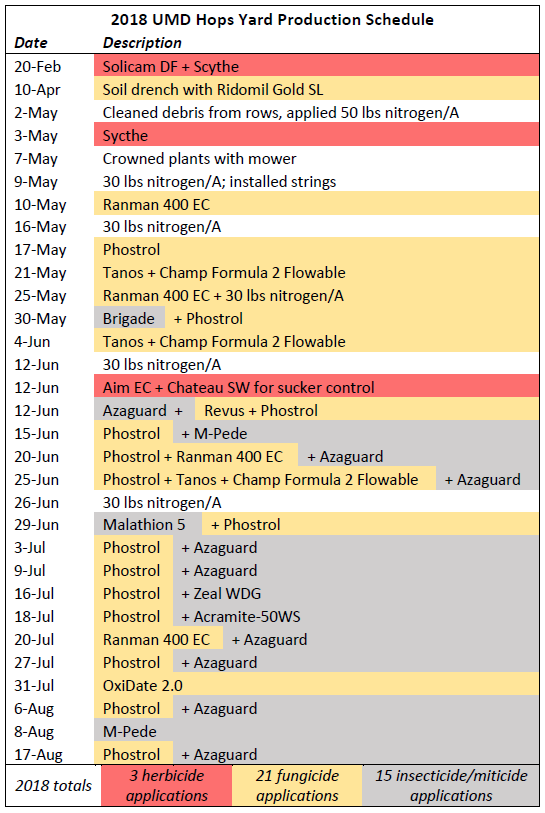
Table 1. Example hops yard production schedule. - Hops cones were harvested on August 12 through August 24 at approximately 25% dry matter using a hops harvester purchased in partnership with Flying Dog Brewery.
- Cones were dried down rapidly to a moisture content of 8% using a dehumidifier inside the oast dryer. This process took less than 24 hours.
- Once dried, the hops cones were processed by freezing them in vacuum-sealed bags. Once all the varieties were harvested and frozen, they were ground up in a hammer mill while still cold and then pelletized using a pelletizer.
- Samples of both dried cones and final pellets were sent to the Enology Analytical Services Laboratory at Virginia Tech for a complete analysis of oils and acids. Samples were also intended to be submitted by the two farmers who partnered with us; due to the excessively wet growing season in 2018, neither grower was able to prioritize sampling and did not submit cones to the lab.
- Within a week of processing, all the hops varieties were sent to Flying Dog for brewing into beer and to be subject to the typical industry-standard screening process. To mimic how a brewer would use the hops in the typical brewing process (without brewing an individual beer with each), Flying Dog replicated its dry-hopping process by adding the hops to a light lager set to the same temperature as a dry hop. From there, Flying Dog’s trained sensory team did an aroma evaluation of the pelletized hops. Each evaluation was performed blind and panelists selected the top two hops out of five groups. Not only did the team evaluate aroma notes, they also noted the intensity of the aroma.
Results in 2018 is a difficult area to address because the weather was detrimental to our two primary cooperators and did not have time to follow through with submitting samples for testing as they had agreed to do with their portion of the grant money. The bright spot of this was however, with our aggressive management of the University of Maryland hop yard, we produced good yields and high quality hops and discussed below. This has influenced growers to look more closely at our research as they strive to improve their yield and quality. Thus, with our significantly higher yields and good quality of hops pellets we are beginning to be seen as a true asset and resource to the brewing community.
Observations of weather conditions in the hops yard began late December, 2017. We saw extreme cold from late December through mid-January with no snow cover and little moisture, which may have contributed to the loss of several Multihead plants. February through April were average for both temperature and moisture. We saw heavy rain in mid-May that resulted in downy mildew disease development, and a limited opportunity to apply a fungicide. Phostrol was applied, but it did not have adequate conditions or time to dry. At the end of May, there was a heavy infestation of leafhoppers, which blow in every year from the south. It depends on the weather patterns, but once they arrive, the population increases very quickly. They reduce the plant’s ability to photosynthesize and need to be managed quickly with an insecticide. That infestation was followed by another round of heavy rain at the beginning of June with a subsequent round of downy mildew.
The first three weeks of July were extremely hot and dry, causing a two-spotted spider mite outbreak, which required a heavy application of miticide to control. Then, the last week of the month saw 5½ inches of rain, a complete reverse of the weather patterns from the last three weeks.
From late June through mid-August, there was an abundance of Japanese beetles, managed with insecticide applications.
It should be noted that there are very few labeled crop protection products specifically for hops, making it difficult to find the right mix of products, but not impossible.
The 2018 season was an extreme reflection of Maryland weather. Heat and humidity were in full force, which set the stage for a similar amount of insect and disease development as we saw in 2017. What we have learned is that intensive care is paramount from the third or fourth week of June to early August, which is a small window for a perennial plant, in order for these plants to thrive.
This project is not only about growing excellent hops in sufficient quantities; they must be useful to craft brewers in the Maryland, so it is also about demonstrating scalable technologies to provide a high-quality product in a usable form to brewers. This meant harvest and post-harvest handling had to be an integral component of this experiment.
Timely harvest is critical and needs to be performed consistently and within a narrow window of time to ensure maximum quality and comparison of varieties. To facilitate this, Flying Dog’s investment in the partnership included joint funding of a mobile harvester. The harvester ensured that each variety was harvested in a timely and consistent fashion, and ensured the data collected on each variety regarding yield was (and will continue to be) consistent (Figure 1). As we discovered through this project, harvest times can vary year-to-year depending on weather conditions that have an effect on the hops maturity. As a rule, the cones should be harvested when moisture content reaches 25% (plus or minus 4%). Due to Maryland's unpredictable weather, this could stage hops harvest anywhere from late July to early September.
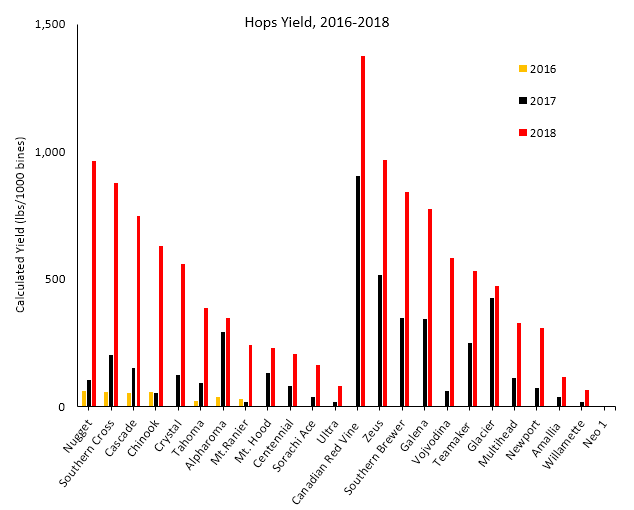
Compared to 2017’s harvest, which stretched from July 29 to September 8, the 2018 harvest was very quick. Most days we had to wait for the plants and ground to dry, so harvest wouldn’t start until early afternoon. Then, it was essential to get the cones into the dryer quickly because the moisture and humidity during the season was so high. This year, we used a dehumidifier inside of the dryer to get the moisture out of the hops as fast as possible (reducing moisture content from about 80% down to 8% in less than 24 hours).
As in 2017, the hops were processed on-site at the research facility after harvest. The hop cones were placed in the oast immediately following harvest and dried within 24 hours to 8% moisture. They were frozen in sealed bags using the liquid nitrogen system until they could be ground up in the hammer mill and then run directly into the pelletizer. The pellets were not heated above 110°F during pelletization, which required close attention. Once pelletized, they were placed in vacuum-sealed bags and frozen.
Most of the same processing techniques were used in 2018 to maintain best practices for processing hops and to minimize the number of variables in this project. Because the hops needed to be harvested in a shorter timeframe in 2018, they were vacuum-packed and stored in a freezer once they were dried. This kept them stable in between processing runs while we finished the harvest. Processing the hops cold also improved efficiency, an unexpected discovery out of necessity.
Samples of both dried cones and final pellets were sent to the Enology Analytical Services Laboratory at Virginia Tech for a complete analysis of oils and acids (Figure 2 and 3). A pre- and post-pelletization comparison showed how pelletizing impacts each hop’s composition. A typical brewer’s evaluation of hops in Yakima Valley does not include any of this quantifiable data—they are evaluated solely from a sensory standpoint. However, because this is a research-based project, we want to make sure our sensory analysis of UMD’s varieties matches up with quantifiable data on the composition of these hops. For the most part, our evaluations are aligning with the aromas and flavors that are typically associated with each hop oil. In the long term, this will help us identify patterns of oil compositions based on the ideal profiles for each variety.
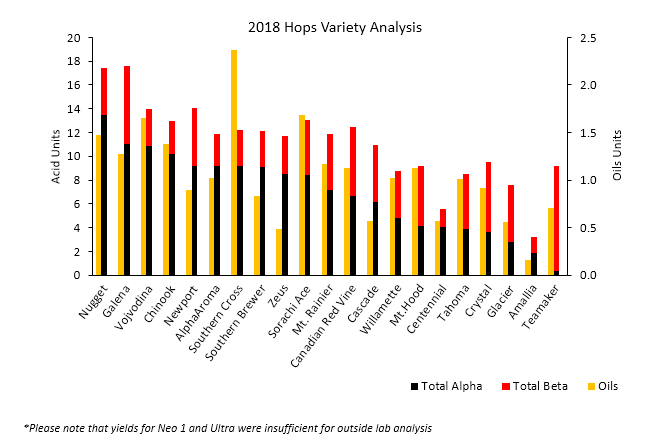
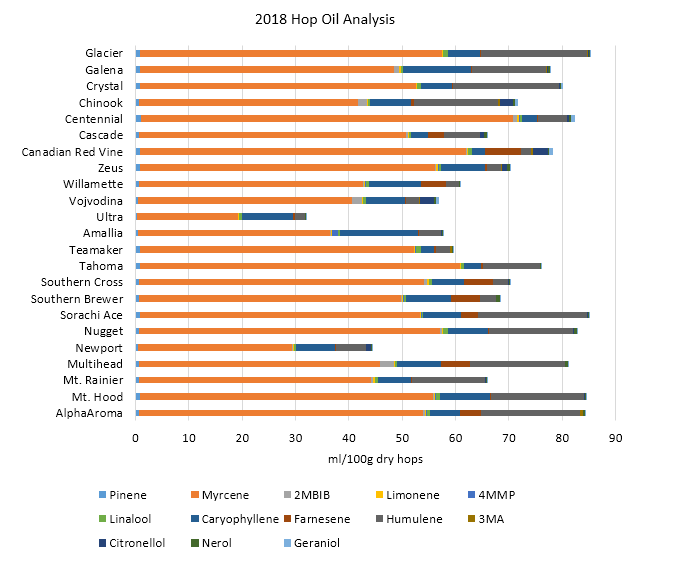
Within a week of processing, Flying Dog received all of the hops from 2018’s harvest, except for the sub-samples that were sent to Virginia Tech for testing. To mimic how a brewer would use the hops in the typical brewing process (without brewing an individual beer with each), Flying Dog replicated its dry-hopping process by adding the hops to a light lager set to the same temperature as a dry hop. From there, Flying Dog’s trained sensory team did an aroma evaluation of the pelletized hops. Each evaluation was performed blind and panelists selected the top two hops out of five groups. Not only did the team evaluate aroma notes, they also noted the intensity of the aroma (Table 2).
Flying Dog’s final analysis of each hop combines the aroma and dry hop evaluations, with the dry hop evaluation weighted heavier because it a better indication of how the hops will perform in a beer. What was most interesting to the brewer was that Flying Dog’s team evaluation of the hops aligned with the oil breakdown data from the lab analysis.
The top rated hops from the 2018 harvest were:
- Vojvodina: Floral and melon aromas in 2018 and 2017, with the addition of a tropical and citrus pop in 2018.
- Southern Cross: In 2017, this hop exhibited a fruit punch profile, but 2018 brought more distinct citrus notes.
- Southern Brewer: This variety traditionally used for bittering, not flavor or aroma; however, this variety grown in the UMD trial possess brew qualities that align with the most popular hops coming out of the Pacific Northwest. Citrus, melon and resin dominate its profile.
- Glacier: Huge fruit and pine with subtle herbal and floral notes in 2018, compared to much more prominent resinous notes the year prior.
- Sorachi Ace: Lemon, citrus and spice profile mimics what is expected from this variety grown in other areas of the United States.
- Amallia: No yield in 2017, but the 2018 harvest brought a unique combination of tropical fruit and earthiness.
- Canadian Red Vine: While this hop had the best yield in 2017 and 2018, the profile is a less-desirable combination of onion, garlic and herb.
In comparison, the top hops from the 2017 harvest were Vojvodina, Glacier, Mt. Hood, Newport, Southern Brewer and Southern Cross. Vojvodina, Glacier, Southern Brewer and Southern Cross remained on 2018’s list, but Mt. Hood and Newport were replaced by Amallia, Canadian Red Vine and Sorachi Ace. The profile differences from 2017 to 2018 show how drastically some hop varieties can change as they reach maturity.

Another objective of this trial is to calculate the cost of production for Maryland hops to help farmers determine if hops are a viable enterprise. With that in mind, the two tables below outline the costs associated with establishing and maintaining the UMD ½-acre hops yard (Table 3 and 4).
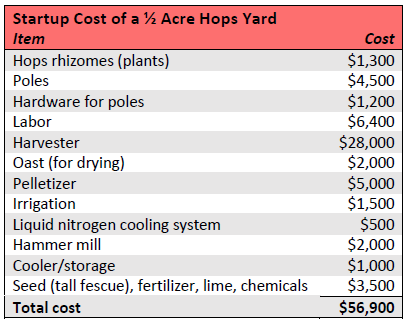

The demand for locally-grown hops has been rapidly increasing with the expansion of the craft brew industry in Maryland. This demand is a potential opportunity for Maryland farmers; however, hops have not been grown in Maryland on a commercial scale in over 100 years. As a result, little information and knowledge exists about hops production in Maryland. Maryland's unique climate and geography poses significant production challenges for hops, which have been traditionally grown and adapted for the much drier climate of the Pacific Northwest. To address this dearth in knowledge, we established a 1/2-acre hops yard on the University of Maryland Experiment Station in Keedysville, MD to test 24 hops varieties to determine best management practices, production cost, and brewing potential/quality of Maryland-grown hops.
The trial was established in 2016 and 2017 and in order to produce high-yielding, high quality hops requires intensive IPM management. Major pests of hops in Maryland include downy mildew, potato leafhopper, spider mites, and Japanese beetles. A proactive scouting and spray schedule is required to manage these pests. Yields of hops varied significantly by variety, with a few near or exceeding 1000 lbs/acre. Some of the top yielding varieties included: Canadian Red Vine, Zeus, Southern Cross, Cascade, Galena, Nugget, and Southern Brewer.
While yield is important; oil, chemical, and brew qualities are equally, if not, more important because the hops need to possess qualities that brewers desire. Based on chemical and brewer analysis, Vojvodina, Southern Cross, Southern Brewer, Glacier, Sorachi Ace, and Amallia had highly desirable brew qualities. Based on yield and brew quality, Maryland farmers have the potential to produce desirable hops for craft brewers.
Education & Outreach Activities and Participation Summary
Participation Summary:
We have been invited to speak at two Mother Earth News sessions, The Maryland Brewer Summit, four Brewery Association of Maryland regional meetings, Carroll County Agribusness club, The Central Maryland Vegetable Conference, the Southeast Hops Conference, and to present a poster at the American Hops Conference in Monterey, CA (Hops Poster Final).
We held custom field days for breweries to see the hop yard and evaluate the hops. The hops yard is open to the public to visit at any time.
We have articles in the Maryland Fruit and Vegetable Headline News and the Maryland Horticulture Technology (2018_HTN_OnlineVersion) newsletter describing our progress and detailing what we've learned about hops production in Maryland up to this point. We've also developed a Maryland Hops web page for growers to access information.
Data from the 2018 trials are to be included in the latest edition of the Maryland Hops Production Guide (Maryland Hops Growers Guide), which is a collaborative publication through University of Maryland Extension and Flying Dog Brewery. The 2017 version was distributed widely (including 100 copies distributed at the American Hops Conference in Monterey, CA.) and the 2018 version has been updated and distributed with more specific information based off of the research conducted through this grant.
We also have a University of Maryland Fact Sheet currently in the peer-review process on Hops Production in Maryland, which includes data collected through funding from this grant.
Learning Outcomes
Although there are relativity few hop farms in Maryland there is tremendous interest in this "trendy" enterprise. The purpose of our work is to provide factual, research-based information to both existing producers and those considering this venture. Collection of data on quality such as this grant has help us collect can help to confirm or refute the claims of terroir with complete analysis of these hops grown in Maryland versus the same hops produced in other areas of the county.
This research is providing data on which varieties perform well in Maryland and how to manage hops in Maryland, which as a result of our much more humid climate, is very different than hops production in the Pacific Northwest. Our data will be utilized by farmers to help them decide of hops are a viable farm enterprise, and if so, which varieties perform the best. So far, we have determined approximate hops yard and production costs per acre, as well as identified varieties that yield well and brewers have desire to purchase. This information is critical to farmers choosing hops as a new crop on their farm.
Project Outcomes
This project has yielded a tremendous amount of data regarding hops production in Maryland. This project is helping us determine best practices for hops production in Maryland and our partnership with Flying Dog Brewery is also allowing us to evaluate the brewing quality of hops grown in Maryland. Interactions with farmers over the course of this project has resulted in several consultations regarding variety selection, weed management, disease and insect management, and general horticultural practices. This research is helping farmers select not only high-yielding hops varieties and how to manage them, but also varieties that posses desirable brew qualities.
One grower in particular planted 3 acres of the variety Southern Cross and another two acres as part of their 2018 expansion because of the interest in that variety that has been generated by this work over the last three seasons.
We also consider steering farmers away from a potentially bad decision to also be a huge outcome/benefit of this project. Several grower consultations have resulted in farmers concluding that hops production is not in the best interest of their business.
This grant and continuation of this research has also helped secure additional grant funding from Flying Dog Brewery at the cost of $7,000.
The information we seek on hops production in Maryland has been lost to this area for nearly 100 years. The recent explosion in craft beer has rekindled the need for this information but it takes time to collect the necessary data to help individuals make informed decisions about entering into hops production. This is a long-term project and the analytical evaluation of this may hop samples is very expensive. This grant has allowed us to collect a second years data on these hops as they mature in Maryland conditions. We have always planned for this to be at least a five year project so that the data collected will be robust, as it will be collected over a variety of weather patterns over at least five years. We will work to secure further funding to allow us to collect this data as the final step up each season to allow us to bench mark over the course of the project.